A Finite Element Method for the Multiterm Time-Space Riesz Fractional Advection-Diffusion Equations in Finite Domain
Abstract
We present an effective finite element method (FEM) for the multiterm time-space Riesz fractional advection-diffusion equations (MT-TS-RFADEs). We obtain the weak formulation of MT-TS-RFADEs and prove the existence and uniqueness of weak solution by the Lax-Milgram theorem. For multiterm time discretization, we use the Diethelm fractional backward finite difference method based on quadrature. For spatial discretization, we show the details of an FEM for such MT-TS-RFADEs. Then, stability and convergence of such numerical method are proved, and some numerical examples are given to match well with the main conclusions.
1. Introduction
Fractional differential equations are different from integer ones, in which the nature of the fractional derivative introduces the memory effect, thus increasing its modeling ability. Recently, many mathematical models with fractional derivatives have been successfully applied in biology, physics, chemistry, and biochemistry, hydrology, and finance [1–3]. The multiterm fractional differential equations have been widely studied in rheology, and, in many cases, the exact solutions are known [4, 5]. Summary of the fractional differential equations can be found in monographs [6–9]. As one of the main branch, fractional partial differential equations have attracted great attention. Therefore, the numerical treatment and supporting analysis of fractional order partial differential equations have become an important research topic that offers great potential.
The FEM is one of the effective numerical methods for solving traditional partial differential equations. For fractional partial differential equations, FEM also can be a useful and effective numerical method. In recent years, some valuable papers are concerned with the FEM for fractional differential equations. Adolfsson et al. [10, 11] considered an efficient numerical method to integrate the constitutive response of fractional order, viscoelasticity based on the FEM. Roop and Ervin [12–15] investigated the theoretical framework for the Galerkin finite element approximation to some kinds of fractional partial differential equations. Li et al. [16] considered numerical approximation of fractional differential equations with subdiffusion and superdiffusion by using difference method and finite element method. Li and Xu [17, 18] proposed a time-space spectral method for time and time-space fractional partial differential equation based on a weak formulation, and a detailed error analysis was carried out. Jiang and Ma [19] considered a high-order FEM for time fractional partial differential equations and proved the optimal order error estimates. Ford et al. [20] studied an FEM for time fractional partial differential equations.
Fractional advection-diffusion equations especially are important in describing and understanding the dispersion phenomena. Analytical solutions of such equations in finite domain have been obtained by Park in [21]. Also, the Riesz fractional advection-diffusion equations (RFADEs) with a symmetric fractional derivative (the Riesz fractional derivative) were derived from the kinetics of chaotic dynamics by [22] and summarized by [23]. Ciesielski and Leszczynski [24] presented a numerical solution for such equations based on the finite difference method.
To increase the modeling ability, some authors considered the equations with the fractional order in both time and spatial variables in RFADEs, which include more information and hence are more interesting. For the time-space fractional advection-dispersion equations, Shen et al. [26] presented the fundamental solution and numerical solution of the Riesz fractional advection-dispersion equation with initial and boundary conditions on a bounded domain, and derived the stability and convergence of their proposed numerical methods. Then, for fractional advection-diffusion equations, Shen et al. [27] presented an explicit difference approximation and an implicit difference approximation for the time-space Riesz-Caputo fractional advection-diffusion equations with initial and boundary conditions on a finite domain.
Recently, some authors considered the applications of multiterm fractional differential equations [29] and the numerical methods for such equations [30–32]. At the same time, the multiterm fractional partial differential equations have been proposed in [33, 34]. The analytical solution and the numerical methods for multiterm time fractional wave-diffusion equations have been investigated in [35, 36]. This motivates us to consider the effective numerical solution for such multiterm fractional partial differential equations.
In this paper, we consider MT-TS-RFADEs in finite domain with the zero Dirichlet boundary conditions. The analytical solution of such MT-TS-RFADEs has been investigated by Jiang et al. in [37]. Here, we present an FEM for a simplified MT-TS-RFADEs and obtain the optimal order error estimates both in semidiscrete and fully discrete cases and derive the stability of such FEM. As far as we are aware, there are few research papers in the published literature written on this topic.
This paper is organized as follows. In Section 2, the preliminaries of the fractional calculation are shown. Then, we give the weak formulation of MT-TS-RFADEs and prove the existence and uniqueness of this problems by the well-known Lax-Milgram theorem. In Section 3, we present the convergence rate of Diethelm’s fractional backward difference method (see [38, 39]) for time discretization. In Section 4, we propose a finite element method based on the weak formulations and carry out the error analysis. In Section 5, we prove the stability of such FEM for MT-TS-RFADEs. Finally, some numerical examples are considered in Section 6.
2. Existence and Uniqueness
Here, we consider the multiterm time fractional differential operator which has the subdiffusion process (see [16]). It is different from (2), which only has one integer order differential operator in time.
Note that the analytical solutions for MT-TS-RFADEs have been studied in [37], in which this problem is well defined. For this problem, some new techniques have been used, such as a spectral representation of the fractional Laplacian operator and the equivalent relationship between the fractional Laplacian operator and the Riesz fractional derivative.
For convenience, we introduce the following definitions and properties. The space derivatives and are the Riesz space fractional derivatives of order β and γ, respectively. The definitions of them can be found in [40].
- (i)
the left Caputo derivative:
() - (ii)
the right Caputo derivative:
() - (iii)
the left Riemann-Liouville derivative:
() - (iv)
the right Riemann-Liouville derivative:
()
The Riesz fractional operators and in (5) can be defined by the left and the right Riemann-Liouville fractional derivatives.
Definition 1 (see [40].)The Riesz fractional derivatives of order θ for n ∈ N, n − 1 < θ < n, on a finite interval 0 ≤ x ≤ X is defined as
Case 1. If 0 < αs < ⋯<α1 < α < 1, (5) is a generalized MT-TS-RFADE with multiterm time fractional diffusion terms with initial conditions given as (6). And especially, if αi = 0, i = 1, …, s and α = 1, then (5) becomes a space fractional advection-diffusion equation with the Riesz space fractional derivatives, which was discussed by Yang et al. [25].
Case 2. If 1 < αs < ⋯<α1 < α < 2, (5) is a generalized MT-TS-RFADE with multiterm time fractional wave terms. In this case, the initial conditions are given as follows:
Case 3. If , (5) becomes a generalized MT-TS-RFADE, which we refer to as a multiterm time-space fractional mixed wave-diffusion equation. In this case, the initial conditions are also given by (13).
In this paper, we just consider Case 1 of (5) with 0 < αs < ⋯<α1 < α < 1. Another two cases with 1 < αs < ⋯<α1 < α < 2 and will be studied in our following work.
We now give some results for fractional operators on these spaces.
Lemma 2 (see [8], [18].)(1) For real 0 < θ < 1, 0 < δ < 1, if v(0) = 0, x ∈ (0, X), then
(2) Let 0 < θ < 1. Then, one has
Lemma 3 (see [18].)Let 0 < θ < 2, θ ≠ 1. Then, for any , then
Lemma 4 (see [17].)For real θ > 0, , then
Based on Lemma 4, we can prove the following existence and uniqueness theorem. During this paper, we use the expression A≲B (A ≳ B) to mean that there exists a positive real number c such that A ≤ cB (A ≥ cB). At the same time, we denote A≅B to mean that A≲B≲A, which means there exist positive real numbers c1, c2 such that A ≤ c1B and B ≤ c2A (i.e., (1/c1)A ≤ B ≤ c2A).
Theorem 5. Assume that 0 < α1 < ⋯<αs < α < 1, 0 < β < 1, 1 < γ < 2 and f ∈ Bα/2,γ/2(I×Ω)′. Then, system (28) has a unique solution in Bα/2,γ/2(I × Ω). Furthermore,
Proof. The existence and uniqueness of the solution is guaranteed by the well-known Lax-Milgram theorem. First, from the equivalence of , , and , for all u, v ∈ Bα/2,γ/2(I × Ω), it follows that
This implies the continuity of the bilinear form 𝒜(·, ·) and the right-hand side function ℱ(v).
We next prove the coercivity of the bilinear operator 𝒜(·, ·). Note that
From the above analysis, we have
By using the well-known Lax-Milgram theorem, there exists a unique solution u ∈ Bα/2,γ/2(I × Ω) such that (28) holds.
To prove the stability estimate (32), by using (34) and (36), we take v = u in (28) and obtain
3. Time Discretization
In this section, we consider the Diethelm fractional backward difference method based on quadrature, which was independently introduced by [39], for ordinary fractional differential equations. Here, we consider this method for the time discretization of (5) and derive the convergence rate for the time-discretization of MT-TS-RFADEs.
Lemma 6 (see [25].)For n − 1 < θ < n (n = 1,2, …) and a function u(x) defined on an unbounded domain (−∞ < x < ∞), the following equality holds:
Definition 7 (see [26].)Suppose the Laplacian has a complete set of orthonormal eigenfunctions ϕn corresponding to eigenvalues on a bounded region 𝒬, that is, on a bounded region 𝒬; B(ϕ) = 0 on ∂𝒬 is one of the standard three homogeneous boundary conditions. Let
Lemma 8 (see [38].)For 0 < α < 1, let the sequence {dj} j = 1,2, … be given by d1 = 1 and . Then, 1 ≤ dj ≤ (sin(πα))/(πα(1 − α))jα, j = 1,2, 3, ….
Let en = Un − u(tn) denote the error in tn. Let ∥·∥ be any given norm. Then, we have the following error estimate.
Theorem 9. Let u(tn) and Un be the solutions of (43) and (52), respectively, and Δt is the time step size. Then, one has
Proof. Subtracting (52) from (51), we obtain the error equation
From Definition 7, note that A is a positive definite elliptic operator with all of eigenvalues λ > 0. Since and Γ(−α) < 0 when 0 < α < 1, we have
Then, by induction and Lemma 8, we have
4. Space Discretization
In this section, we consider the space discretization of (5) with homogeneous boundary condition. Using the FEM, we obtain the numerical approximation solution in a finite domain. Then, we prove the convergence rate of this method. Let Ω = [0, X] be an interval in one-dimensional space. All of the results in this section can be generalized into the cases of high dimension.
Proof. Let Ih be the projection operator from to Sh. From the definition of L2-norm, we obtain
Note that
Theorem 11. For 0 < αs < ⋯<α1 < α < 1, let uh and u be the solutions of (63) and (61), respectively. Then, it holds
Proof. We write
In order to estimate ϑ, for all χ ∈ Sh, we get
Choosing χ = ϑ(t) and integrating on both sides with respect to t on [0, T], we obtain
By Lemmas 2–4, for any small ϵ > 0, we have
For sufficiently small ϵ > 0, by (75), we obtain
For the reason that the time and space fractional derivatives, we introduce the complete form of this FEM. In view of space discretization, we first pose the finite-dimensional problem to find uh(t, ·) ∈ Sh such that (63) holds.
5. Stability of the Numerical Method
In this section, we analyze the stability of the FEM for MT-TS-RFADEs (5). Now, we do some preparation before proof. Based on the definition of coefficients in Section 3, we can obtain the following lemma easily.
Lemma 12. For 0 < α < 1, the coefficients , (k = 1, …, n) satisfy the following properties:
- (i)
and for k = 1,2, …, n,
- (ii)
.
Now, we report the stability theorem of this FEM for MT-TS-RFADEs as follows.
Theorem 13. The FEM defined in (81) is unconditionally stable.
Proof. Let Un denote the approximation to uh at t = tn and χ(·) = Un(·) and the right-hand side . From (63), we have
We prove the stability of (63) by induction. From the beginning, we have
6. Numerical Tests
Based on the above analysis, we present three numerical examples for MT-TS-RFADEs to demonstrate the efficiency of our theoretical analysis. The main purpose is to check the convergence behavior of numerical solutions with respect to time step size Δt and space step size Δx, which have been shown in Theorems 9 and 11.
Example 1. Consider MT-TS-RFADE, in t ∈ [0,0.5], x ∈ [0,1],
Choosing α = 0.9 and α1 = 0.2 in time fractional operators and β = 0.4γ = 1.6 in the space Riesz fractional operators, we can obtain the numerical approximation to the exact solution of (88) on finite domain [0,0.5]×[0,1], with space step size Δx = 0.05 and time step size Δt = 0.01. In Figure 1, one can see that the numerical solution matches well with the exact solution.
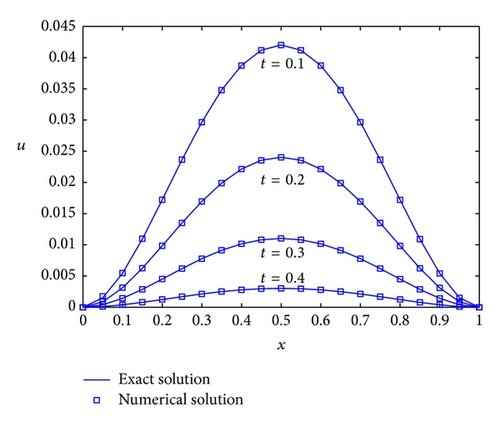
Example 2. Consider MT-TS-RFADE (88) with conditions as follows:
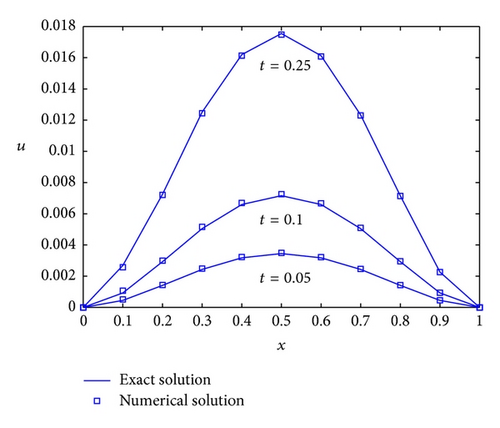
Example 3. Consider MT-TS-RFADE (88) with the zero Dirichlet boundary conditions, for t ∈ [0,1], x ∈ [0,1]. We require that the exact solution is u(t, x) = sin(2πt)x2(1 − x) 2.
For this example, in the first test, we obtain the numerical solution and exact solution when t = 0.05, 0.1, 0.25, 0.4 in Figure 3, where we choose time step size Δt = 0.01 and space step size Δx = 0.01 with α1 = 0.3, α = 0.5, and β = 0.9, γ = 1.9.
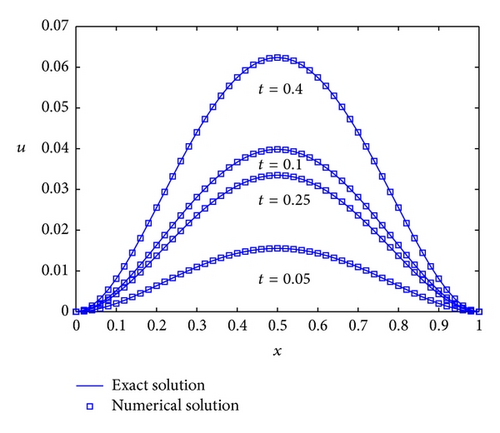
In the second test, we check the convergence rates of numerical solutions with respect to the fractional orders α1, α, β, and γ. We fix α1 = 0.2, α = 0.8, β = 0.8, and γ = 1.8 and choose Δx = 0.001 which is small enough such that the space discretization errors are negligible as compared with the time errors. Choosing step size Δt = 1/2i (i = 1, …, 5), we present Table 1 with the convergence rate which is equal to 1.2, as Theorem 9 predicted. Table 2 shows the spatial approximate convergence rate, by fixing Δt = 0.001 and choosing Δx = 1/2i (i = 1, …, 5). From Theorem 11, the convergence rate should be equal to or less than 1.1 (i.e., η − γ/2 for η = 2 and γ = 1.8). In Table 2, the numerical results match well with such conclusion. Here, we also report both the L2-norm and H1-norm of errors in Figure 4.
| Δx | Δt | H1-norm | L2-norm | cvge. rate |
|---|---|---|---|---|
| 0.001 | 1/2 | 7.9601 × 10−3 | 1.0925 × 10−3 | |
| 0.001 | 1/4 | 3.4906 × 10−3 | 4.7906 × 10−4 | 1.1893 |
| 0.001 | 1/8 | 1.5238 × 10−3 | 2.0914 × 10−4 | 1.1957 |
| 0.001 | 1/16 | 6.6273 × 10−4 | 9.0956 × 10−5 | 1.2012 |
| 0.001 | 1/32 | 2.8667 × 10−4 | 3.9343 × 10−5 | 1.2090 |
| Δt | Δx | H1-norm | L2-norm | cvge. rate |
|---|---|---|---|---|
| 0.001 | 1/2 | 3.2591 × 10−2 | 4.4731 × 10−3 | |
| 0.001 | 1/4 | 1.6288 × 10−2 | 2.2356 × 10−3 | 1.0006 |
| 0.001 | 1/8 | 8.1364 × 10−3 | 1.1167 × 10−3 | 1.0014 |
| 0.001 | 1/16 | 4.0602 × 10−3 | 5.5723 × 10−4 | 1.0029 |
| 0.001 | 1/32 | 2.0220 × 10−3 | 2.7751 × 10−4 | 1.0057 |
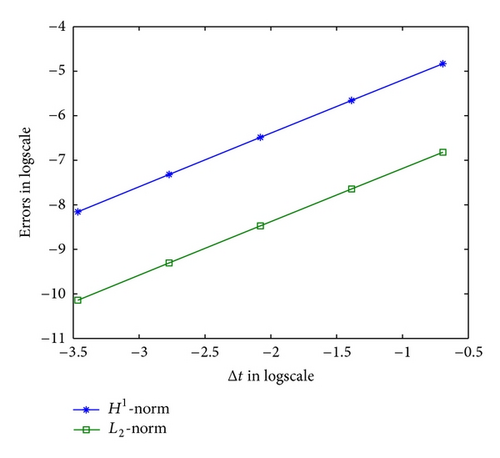
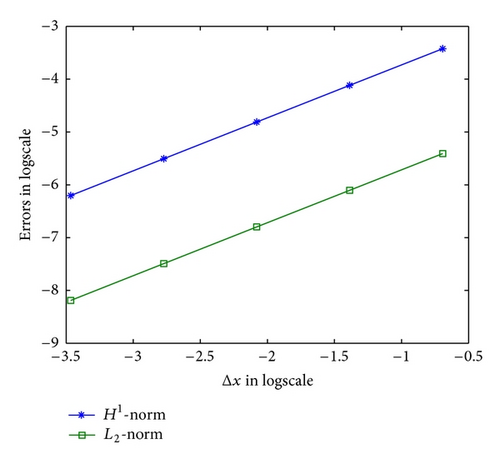
Acknowledgments
The authors are grateful to the referees for their valuable comments. This work is supported by the National Natural Science Foundation of China (11101109 and 11271102), the Natural Science Foundation of Hei-long-jiang Province of China (A201107), and SRF for ROCS, SEM.




